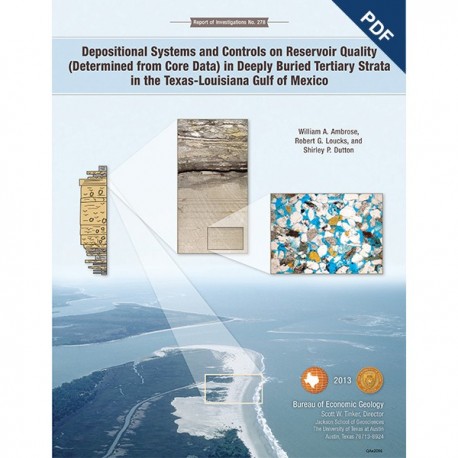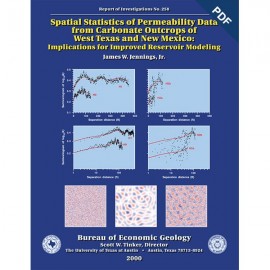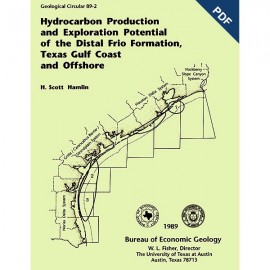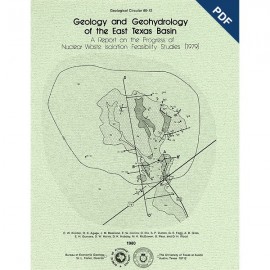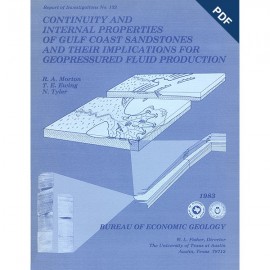Reports of Investigations
-
Books & Reports
- Reports of Investigations
- Guidebooks
- Udden Series
- Geological Circulars
- Down To Earth
- Atlases of Major Oil and Gas Reservoirs
- Texas Memorial Museum Publications
- Environmental Geologic Atlas of the Texas Coastal Zone
- Mineral Resource Circulars
- Other Reports
- Seminars and Workshops
- Handbooks
- Submerged Lands of Texas
- Symposia
- Annual Reports
- Open File Reports
-
Maps & Cross Sections
- Thematic Maps
- Miscellaneous Maps, Charts & Sections
- Geologic Atlas of Texas
- STATEMAP Project Maps
- Geologic Quadrangle Maps
- Cross Sections
- Highway Geology Map
- Energy and Mineral Resource Maps
- Shoreline Change and Other Posters
- Wilcox Group, East Texas, Geological / Hydrological Folios
- Bouguer Gravity Atlas of Texas
- River Basin Regional Studies
- Featured Maps
- Posters
- Teachers & the Public
-
Geological Society Publications
- Gulf Coast Association of Geological Societies
- Alabama Geological Society
- Austin Geological Society
- Corpus Christi Geological Society
- Houston Geological Society
- Lafayette Geological Society
- Mississippi Geological Society
- New Orleans Geological Society
- South Texas Geological Society
- GCS SEPM Publications
- Historic BEG & UT Series
Depositional Systems and Control Reservoir Quality. Digital Download
RI0278D
Depositional Systems and Controls on Reservoir Quality (Determined from Core Data) in Deeply Buried Tertiary Strata in the Texas-Louisiana Gulf of Mexico, by W. A. Ambrose, R. G. Loucks, and S. P. Dutton. 80 p., 64 figs., 1 table, 2013. doi.org/10.23867/RI0278DDigital Version.
For a print version: RI0278.
RI0278D. Depositional Systems and Controls on Reservoir Quality (Determined from Core Data) in Deeply Buried Tertiary Strata in the Texas-Louisiana Gulf of Mexico, by W. A. Ambrose, R. G. Loucks, and S. P. Dutton. 80 p., 64 figs., 1 table, 2013. ISSN:2475-3637. doi.org/10.23867/RI0278D. Downloadable PDF.
To purchase this publication in book format, please order RI0278.
To purchase this publication on CD-ROM, please order RI0278CD.
About This Publication
In this report, the authors used whole-core data to provide a framework for interpreting depositional origin, reservoir quality, and mineralogical composition in deeply buried (>10,000-ft) Tertiary strata in the Texas-Louisiana Gulf of Mexico.
ABSTRACT
A study of the deeply buried (>10,000 ft [>3,050 m]) Tertiary section in the Gulf of Mexico, which makes use of whole cores from 12 wells in Louisiana and Texas, provides a framework for interpreting depositional origin and demonstrates that relative position within the sequence-stratigraphic framework and facies tract can exert powerful controls on reservoir quality, even in deeply buried successions. Some wells in the Texas-Louisiana Gulf of Mexico in deep (>19,000-ft [>5,790-m]) sandstones of deep-water origin in the lower Wilcox Group have comparable porosity and permeability values relative to those in shallower (<13,500-ft [<4,115-m]) lower Wilcox shallow-marine highstand and transgressive systems tracts, although porosity values and relative abundance of porosity types (intergranular, secondary, and microporosity) vary between these cores. Similar examples occur in the Frio Formation, where deep-water sandstones of lowstand origin in southwest Louisiana, associated with sediment bypass, have values of 20 to 30 percent porosity and more than 1 darcy (D) permeability, although they are more than 16,000 ft (>4,878 m) deep. Facies variability, mineralogical composition, and sequence-stratigraphic origin are additional factors that influence porosity and permeability. Considerable variation exists in porosity and permeability values between deltaic and shoreface sandstones, as well as between transgressive and progradational sandstones in deeply buried strata in the Gulf of Mexico. Similar variation also exists in porosity and permeability values between turbidite channel-fill, levee overbank, and debris-flow sandstones in deep-water systems in the Wilcox Group and Yegua Formation. Regions where higher reservoir quality may exist in the deep subsurface are delineated by integrating sequence stratigraphy, facies variability, mineralogy, and environmental parameters such as temperature and pressure. These data are correlated to empirical reservoir quality from wireline logs and cores to infer facies controls on reservoir quality.
Keywords: Tertiary, Gulf of Mexico, Gulf Coast, reservoir quality
CONTENTS
Abstract
Introduction
Lowstand Systems Tract
Transgressive Systems Tract
Highstand Systems Tract
Scope, Objectives, and Data
Lower Wilcox Group
Shell No. 2 Wolfe (Wave-Modified, Fluvial-Dominated Delta)
Regional Paleogeographic Setting and Description
Interpretation
Reservoir Quality
Amoco No. 1 Longbell (Wave-Modified, Fluvial-Dominated Delta)
Regional Paleogeographic Setting and Description
Interpretation and Reservoir Quality
ARCO No. 1 Crews (Slope Channel, Levee, and Debris-Flow Deposits)
Regional Paleogeographic Setting
Description: Lower Interval
Interpretation: Lower Interval
Reservoir Quality: Lower Interval
Description: Middle Interval
Interpretation: Middle Interval
Reservoir Quality: Middle Interval
Description: Upper Interval
Interpretation and Reservoir Quality: Upper Interval
Upper Wilcox Group
Harcor No. 2 Bellelo (Wave-Dominated Delta)
Regional Paleogeographic Setting and Description
Interpretation and Reservoir Quality
Sun No. 1 Crown Zellerbach (Shoreface)
Regional Paleogeographic Setting and Description
Interpretation and Reservoir Quality
Yegua Formation
ARCO No. 1 Crews (Outer Slope to Basin Floor)
Description
Interpretation and Reservoir Quality
Ladd Petroleum No. 1 Chang Trustee (Basin-Floor Fan)
Regional Paleogeographic Setting and Description
Interpretation and Reservoir Quality
Frio Formation
ARCO No. D-1 Miami (Lower Slope and Basin-Floor Fan)
Regional Paleogeographic Setting and Description
Interpretation and Reservoir Quality
ARCO No. X-1 Miami (Slope)
Regional Paleogeographic Setting and Description
Interpretation and Reservoir Quality
ARCO No. 1 Hamilton (Fluvial-Dominated Delta)
Regional Paleogeographic Setting and Description
Interpretation and Reservoir Quality
Lower Miocene
Pan American No. 1 SL 4210 (Slope)
Regional Paleogeographic Setting and Description
Interpretation and Reservoir Quality
Amoco No. 1 SL 11736 (Lower Slope to Basin-Floor Fan)
Regional Paleogeographic Setting and Description
Interpretation and Reservoir Quality
Upper Miocene
Sun No. 17 Lake Pelto (Deltaic and Tidally Influenced Interdistributary Bay)
Regional Paleogeographic Setting and Description
Reservoir Quality and Interpretation
Sequence Tracts and Facies Controls on Reservoir Quality
Lower Wilcox Group
Upper Wilcox Group
Yegua and Frio Formations
Miocene
Areal Facies Distribution and Reservoir Quality
Wilcox Group
Yegua Formation
Frio Formation
Lower Miocene
Upper Miocene
Conclusions
Acknowledgments
References
Figures
1. Location of cored wells in this report
2. General depositional setting of cored wells in this report
3. Chronostratigraphic chart of major Tertiary stratigraphic units in the Gulf of Mexico
4. Lower Wilcox paleogeography of Gulf Coast region and regional setting of Shell No. 2 Wolfe, Amoco No. 1 Longbell, and ARCO No. 1 Crews wells
5. Log response, description, and reservoir-quality data for the Shell No. 2 Wolfe core in lower Wilcox Group
6. Core photographs from Shell No. 2 Wolfe core
7. Quartz-feldspar-rock fragments cross-plots for lower Wilcox cores
8. Photomicrograph showing moderate overall porosity in transgressive deposits in Shell No. 2 Wolfe core
9. Description, log response, and porosity and permeability data for Amoco No. 1 Longbell core in lower Wilcox Group
10. Photographs of highstand proximal-delta-front deposits in Amoco No. 1 Longbell core in lower Wilcox Group
11. Photographs from transgressive deposits in Amoco No. 1 Longbell core in lower Wilcox Group
12. Photomicrograph of highstand proximal-delta-front deposits in Amoco No. 1 Longbell core
13. Log response, core description, and porosity and permeability data in lower part of ARCO No. 1 Crews well in lower Wilcox Group
14. Photographs of lowstand deep-water facies in ARCO No. 1 Crews core in lower Wilcox Group
15. Log response, core description, and porosity and permeability data in middle part of ARCO No. 1 Crews well in lower Wilcox Group
16. Core description and porosity and permeability data in upper part of ARCO No. 1 Crews well
in lower Wilcox Group17. Regional paleogeographic setting of upper Wilcox Group and location of
Harcor No. 2 Bellelo and Sun No. 1 Zellerbach wells
18. Log response, oil-producing zones, core description, and porosity and permeability data for Harcor No. 2 Bellelo well
19. Photographs of Harcor No. 2 Bellelo core in upper Wilcox Group
20. Photomicrograph of upper-shoreface deposits in Harcor No. 2 Bellelo core, displaying abundant intergranular porosity and secondary porosity
21. Quartz-feldspar-rock fragments cross-plots for upper Wilcox cores in this study
22. Log response, core description, and porosity-permeability data for Sun No. 1 Zellerbach well
23. Photographs of the lower siltstone-dominated, shallow-marine highstand section in Sun No. 1 Zellerbach core in upper Wilcox Group
24. Photographs of lowstand, upper-shoreface deposits in Sun No. 1 Zellerbach core in upper Wilcox Group
25. Log and core section demonstrating continuity of lowstand shoreface systems in Upper Cretaceous Cardium Formation in Alberta
26. Photomicrograph of lowstand, upper-shoreface deposits in Sun No. 1 Zellerbach core
displaying abundant intergranular porosity
27. Regional paleogeographic setting of Yegua Formation and location of ARCO No. 1 Crews and
Ladd Petroleum No. 1 Chang Trustee wells
28. Core description and porosity and permeability data for ARCO No. 1 Crews well in Yegua Formation
29. Photographs from lowstand slope deposits in ARCO No. 1 Crews core in Yegua Formation
30. Photomicrograph of channel-fill turbidite deposits in Yegua Formation
31. Quartz-feldspar-rock fragments cross-plots for Yegua cores
32. Core description and limited porosity and permeability data for Ladd Petroleum No. 1 Chang Trustee well
33. Core photographs from Yegua Formation in Ladd Petroleum No. 1 Chang Trustee well
34. Photomicrograph of amalgamated channel-fill turbidite sandstone in Yegua Formation
35. Location of three cored wells in Frio Formation
36. Seismic transect from 2-D data in southwest Louisiana
37. Log response, core description, and porosity-permeability data for ARCO No. D-1 Miami well
38. Photographs of ARCO No. D-1 Miami core in Frio Formation
39. Photomicrograph of high porosity in channel-fill turbidite facies
40. Quartz-feldspar-rock fragments cross-plots for Frio cores
41. Log response, core description, and porosity data for ARCO No. X-1 Miami well
42. Photographs of the ARCO No. X-1 Miami core in the Frio Formation
43. Photomicrograph of low-porosity highstand channel-fill turbidite facies with abundant quartz cement
44. Log response and core description of ARCO No. 1 Hamilton well
45. Photographs of ARCO No. 1 Hamilton core in Frio Formation
46. Photomicrograph of channel-mouth-bar sandstone in Frio Formation
47. Location of Pan American No. 1 SL 4210 and Amoco No. 1 SL 11736 wells
48. Log response and core description of Pan American No. 1 SL 4210 well
49. Photographs of lower Miocene Pan American No. 1 SL 4210 core
50. Photomicrograph of low-porosity upper-slope-channel facies with abundant quartz cement
51. Quartz-feldspar-rock fragments cross-plots for lower Miocene cores
52. Log response, core description, and porosity data for Amoco No. 1 SL 11736 well
53. Photographs of lower Miocene Amoco No. 1 SL 11736 core
54. Photomicrograph of low-porosity quartz-cemented facies in debrite facies at top of channel-fill section
55. Location of Sun No. 17 Lake Pelto well displayed on map of upper Miocene paleogeography
56. Log response and core description of Sun No. 17 Lake Pelto well
57. Photographs of Sun No. 17 Lake Pelto core
58. Photomicrograph of excellent porosity at top of transgressive facies
59. Quartz-feldspar-rock fragments cross-plot for upper Miocene core in Sun No. 17 Lake Pelto well
60. A modern analog for tidally influenced microtidal embayment deposits and detailed map of Barataria Pass
61. Average values and ranges for reservoir-quality data in lower Wilcox Shell No. 2 Wolfe, Amoco No. 1 Longbell, and ARCO No. 1 Crews wells
62. Average values and ranges for reservoir-quality data in upper Wilcox Harcor No. 2 Bellelo and Sun No. 1 Zellerbach wells
63. Average values and ranges for reservoir-quality data in ARCO No. 1 Crews and Ladd No. 1 Chang wells in Yegua Formation
64. Average values and ranges for reservoir-quality data in ARCO No. D-1 Miami and ARCO No. X-1 Miami wells in Frio Formation
Table
1. Summary of porosity and permeability data from cores
Citation
Ambrose, W. A., Loucks, R. G., and Dutton, S. P., 2013, Depositional Systems and Controls on Reservoir Quality (Determined from Core Data) in Deeply Buried Tertiary Strata in the Texas-Louisiana Gulf of Mexico: The University of Texas at Austin, Bureau of Economic Geology, Report of Investigations No. 278, 80 p. doi.org/10.23867/RI0278D.
